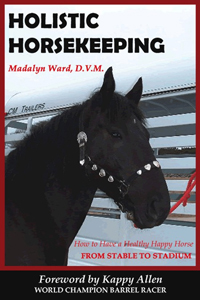February 2020
Holistic Horsekeeping
How to have a healthy happy horse.
Volume 25, Number 2
================
In This Issue:
1. Introduction to Holistic Medicine
2. Holistic Horsekeeping Resources
================
1. Introduction to Holistic Medicine
Palliation, Suppression, and Cure
There is a lot of focus on “alternative,” “natural,” “herbal,” and “holistic” health care these days, for both humans and animals. There are goods and services available in all these areas from a variety of different sources. With so much available, it can be difficult to figure out what is best for your particular horse. It’s even confusing to try to figure out what these terms really mean! Although I do use “alternative,” “natural,” and “herbal” methods in my practice, I’ve found that using a holistic approach produces the best results because it incorporates not only these methods but more, including traditional medicine when necessary.
So what does “holistic” really mean?
~ Holistic healing means approaching each patient as an individual in order to support or restore health.~
A holistic approach considers anything and everything that could affect the health of the patient, and works with the patient’s own healing forces by either removing blockages or supplying needed substances. Conventional medicine, on the other hand, looks at disease rather than health, and seeks to treat the symptoms of that disease rather than support the patient’s own healing force and process.
While some people believe that the difference between conventional and holistic approaches is that conventional medicine uses drugs while a holistic approach uses natural substances, the difference really lies in the basic philosophy of each approach. Conventional medicine focuses on the disease, while holistic medicine considers all aspects that support or detract from a patient’s health. With holistic healing, patients usually experience fewer side effects, have less resistance, and are at least as healthy, if not more healthy, after treatment.
What About Symptoms?
Symptoms are the clues that tell us our horses are not healthy and are always the first thing we want to address. Regardless of what therapy or approach is used, there are three basic ways of handling symptoms:
• palliation
• suppression
• cure
As you will see, the following statements demonstrate another fundamental difference between conventional and holistic medicine.
Conventional medicine focuses primarily on palliating or suppressing symptoms–in other words, masking or temporarily alleviating the symptoms without addressing the root cause of those symptoms. When the root cause of symptoms is not addressed, they will appear again and again, often in states that are more and more difficult to palliate or suppress.
Holistic healing, on the other hand, while concerned with symptoms, is focused on actually curing the cause of the symptoms. To a holistic practitioner, symptoms are the body’s way of telling us what it needs in order to become balanced and healthy. Please think about this difference for a moment because it is a critical point in understanding the holistic approach.
If we want our animals to be healthy, we have to stop palliating and suppressing symptoms and start curing them! Let’s take a closer look at the difference between palliation, suppression, and cure.
Palliating Symptoms
When symptoms are “palliated,” you can expect them to disappear temporarily during a course of treatment, but they tend to return immediately or soon after treatment is discontinued. With this approach the disease process itself has not been addressed and continues to advance, often requiring larger doses of medicine to keep symptoms at bay. Giving Bute for arthritis pain is a good example of palliation–the drug eases the pain but doesn’t address the root cause of the arthritis. In this example the pain is actually the body’s way of telling us something is wrong in the joints. More than likely, the joint fluid has been damaged by an excess of circulating free radicals, which prevents it from properly nourishing the joint cartilage. The cartilage then begins to break down faster than the body can replace it, creating instability in the joint. The body’s response to all of this is to deposit calcium around the joint in an effort to stabilize it. This whole process can be slowed or reversed in its early stages, but if symptoms are only palliated the process will continue and permanent damage will eventually occur. Palliation is such a common response to symptoms of disease that you can probably think of many examples yourself.
Suppressing Symptoms
While palliation can eventually result in permanent damage, suppression of symptoms can be even more harmful. When symptoms are “suppressed,” they will disappear and will not reappear, but the animal’s overall health worsens. This usually occurs with the use of powerful drugs such as corticosteroids, but can also occur when milder drugs are used on a weak animal. For example, a common therapy for treating allergic skin reaction is to give steroids. These drugs will stop the rash but will likely bring about an undesirable change in behavior as well. As a result, your once friendly and willing horse is now aggressive and hateful. This is suppression. The skin rash was a sign of liver imbalance, and when this expression of the imbalance was blocked by steroids the body was forced to express itself at a deeper and more serious level. In this example, besides serious personality changes, the energy of the disease will also eventually manifest again physically, but in another, more serious way than a skin rash. In this case that might typically be actual liver damage.
Curing the Disease
Now you want to hear about CURE! Curing an animal takes time and patience, as the animal’s system must be strengthened, obstacles to cure removed, and overall systemic balance restored. This involves an in-depth look at the nutrition, management, and personality of the patient–a comprehensive approach that is not considered in a conventional treatment of symptoms alone. In the arthritic horse, for example, I would give the horse the nutritional support it needed to help the cartilage heal faster. I would also investigate the source of free radicals that were causing damage to the joints. If I found the source to be external, I would remove it and probably add appropriate supplements to the diet to combat the existent free radicals, but if the source were internal, then I would use a healing method such as acupuncture or homeopathy to bring the body back into balance. With cure, not only do symptoms disappear but the vital force comes into full expression. The hair coat shines, the eyes brighten, and the playful spirit returns, even in older animals.
A Review of Palliation, Suppression, and Cure
Remember, the vital force produces symptoms in an effort to heal. If symptoms are palliated, they improve as long as the treatment is continued but return when the treatment stops. If symptoms are suppressed, they disappear but the overall condition of the patient worsens. The imbalance or disease continues during both palliation and suppression, so higher dosages or more frequent treatments are needed in order to keep symptoms controlled. To actually cure the disease, the patient must be brought back into balance or a state of health where the body no longer needs to produce symptoms. This process involves an in-depth look at the individual and the conditions that brought the patient to a diseased state in the first place.
2. Holistic Horsekeeping Resources
To continue learning more about using holistic medicine and caring holistically for your horse, get the Holistic Horsekeeping book from Madalyn Ward, DVM. It is available on her website in paperback, or on Kindle in digital or paperback formats. You’ll also find online courses, ebooks, audios, DVD’s , books and Kindle books at https://holistichorsekeeping.com/education.html; or the horse temperament typing online class at https://horsetemperament.com/class.html. We also offer a library of articles, a blog full of information, a mentoring program, consults with Dr. Ward, a short term boarding option, and a variety of equine products Dr. Ward recommends and uses herself. From education to natural supplements, we have it all at www.holistichorsekeeping.com.
++++ Copyright | Getting On and Off the List ++++
Unless otherwise attributed, all material is written and edited by Madalyn Ward, DVM. Copyright (c) 2020 HolisticHorsekeeping.com and Madalyn Ward, DVM. All rights reserved.
If you like the material in this newsletter please let your friends know about it. You may reprint material in other electronic or print publications provided the above copyright notice and a link to http://www.holistichorsekeeping.com is included in the credits.
You can get off this list by sending an email to info@holistichorsekeeping.com.
When you forward this material, please send the entire newsletter. Thanks!
Please also enjoy all of Dr. Ward’s web resources:
http://www.holistichorsekeeping.com
http://blog.horseharmony.com
https://www.facebook.com/HolisticHorsekeeping
https://www.facebook.com/HorseHarmony
Twitter: madalynward

